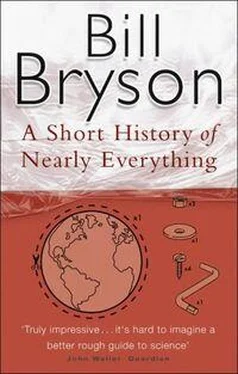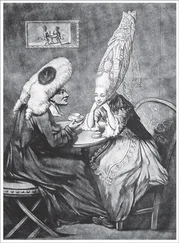As a leading member of the Académie Royale des Sciences, he was also required to take an informed and active interest in whatever was topical-hypnotism, prison reform, the respiration of insects, the water supply of Paris. It was in such a capacity in 1780 that Lavoisier made some dismissive remarks about a new theory of combustion that had been submitted to the academy by a hopeful young scientist. The theory was indeed wrong, but the scientist never forgave him. His name was Jean-Paul Marat.
The one thing Lavoisier never did was discover an element. At a time when it seemed as if almost anybody with a beaker, a flame, and some interesting powders could discover something new-and when, not incidentally, some two-thirds of the elements were yet to be found-Lavoisier failed to uncover a single one. It certainly wasn’t for want of beakers. Lavoisier had thirteen thousand of them in what was, to an almost preposterous degree, the finest private laboratory in existence.
Instead he took the discoveries of others and made sense of them. He threw out phlogiston and mephitic airs. He identified oxygen and hydrogen for what they were and gave them both their modern names. In short, he helped to bring rigor, clarity, and method to chemistry.
And his fancy equipment did in fact come in very handy. For years, he and Madame Lavoisier occupied themselves with extremely exacting studies requiring the finest measurements. They determined, for instance, that a rusting object doesn’t lose weight, as everyone had long assumed, but gains weight-an extraordinary discovery. Somehow as it rusted the object was attracting elemental particles from the air. It was the first realization that matter can be transformed but not eliminated. If you burned this book now, its matter would be changed to ash and smoke, but the net amount of stuff in the universe would be the same. This became known as the conservation of mass, and it was a revolutionary concept. Unfortunately, it coincided with another type of revolution-the French one-and for this one Lavoisier was entirely on the wrong side.
Not only was he a member of the hated Ferme Générale, but he had enthusiastically built the wall that enclosed Paris-an edifice so loathed that it was the first thing attacked by the rebellious citizens. Capitalizing on this, in 1791 Marat, now a leading voice in the National Assembly, denounced Lavoisier and suggested that it was well past time for his hanging. Soon afterward the Ferme Générale was shut down. Not long after this Marat was murdered in his bath by an aggrieved young woman named Charlotte Corday, but by this time it was too late for Lavoisier.
In 1793, the Reign of Terror, already intense, ratcheted up to a higher gear. In October Marie Antoinette was sent to the guillotine. The following month, as Lavoisier and his wife were making tardy plans to slip away to Scotland, Lavoisier was arrested. In May he and thirty-one fellow farmers-general were brought before the Revolutionary Tribunal (in a courtroom presided over by a bust of Marat). Eight were granted acquittals, but Lavoisier and the others were taken directly to the Place de la Revolution (now the Place de la Concorde), site of the busiest of French guillotines. Lavoisier watched his father-in-law beheaded, then stepped up and accepted his fate. Less than three months later, on July 27, Robespierre himself was dispatched in the same way and in the same place, and the Reign of Terror swiftly ended.
A hundred years after his death, a statue of Lavoisier was erected in Paris and much admired until someone pointed out that it looked nothing like him. Under questioning the sculptor admitted that he had used the head of the mathematician and philosopher the Marquis de Condorcet-apparently he had a spare-in the hope that no one would notice or, having noticed, would care. In the second regard he was correct. The statue of Lavoisier-cum-Condorcet was allowed to remain in place for another half century until the Second World War when, one morning, it was taken away and melted down for scrap.
In the early 1800s there arose in England a fashion for inhaling nitrous oxide, or laughing gas, after it was discovered that its use “was attended by a highly pleasurable thrilling.” For the next half century it would be the drug of choice for young people. One learned body, the Askesian Society, was for a time devoted to little else. Theaters put on “laughing gas evenings” where volunteers could refresh themselves with a robust inhalation and then entertain the audience with their comical staggerings.
It wasn’t until 1846 that anyone got around to finding a practical use for nitrous oxide, as an anesthetic. Goodness knows how many tens of thousands of people suffered unnecessary agonies under the surgeon’s knife because no one thought of the gas’s most obvious practical application.
I mention this to make the point that chemistry, having come so far in the eighteenth century, rather lost its bearings in the first decades of the nineteenth, in much the way that geology would in the early years of the twentieth. Partly it was to do with the limitations of equipment-there were, for instance, no centrifuges until the second half of the century, severely restricting many kinds of experiments-and partly it was social. Chemistry was, generally speaking, a science for businesspeople, for those who worked with coal and potash and dyes, and not gentlemen, who tended to be drawn to geology, natural history, and physics. (This was slightly less true in continental Europe than in Britain, but only slightly.) It is perhaps telling that one of the most important observations of the century, Brownian motion, which established the active nature of molecules, was made not by a chemist but by a Scottish botanist, Robert Brown. (What Brown noticed, in 1827, was that tiny grains of pollen suspended in water remained indefinitely in motion no matter how long he gave them to settle. The cause of this perpetual motion-namely the actions of invisible molecules-was long a mystery.)
Things might have been worse had it not been for a splendidly improbable character named Count von Rumford, who, despite the grandeur of his title, began life in Woburn, Massachusetts, in 1753 as plain Benjamin Thompson. Thompson was dashing and ambitious, “handsome in feature and figure,” occasionally courageous and exceedingly bright, but untroubled by anything so inconveniencing as a scruple. At nineteen he married a rich widow fourteen years his senior, but at the outbreak of revolution in the colonies he unwisely sided with the loyalists, for a time spying on their behalf. In the fateful year of 1776, facing arrest “for lukewarmness in the cause of liberty,” he abandoned his wife and child and fled just ahead of a mob of anti-Royalists armed with buckets of hot tar, bags of feathers, and an earnest desire to adorn him with both.
He decamped first to England and then to Germany, where he served as a military advisor to the government of Bavaria, so impressing the authorities that in 1791 he was named Count von Rumford of the Holy Roman Empire. While in Munich, he also designed and laid out the famous park known as the English Garden.
In between these undertakings, he somehow found time to conduct a good deal of solid science. He became the world’s foremost authority on thermodynamics and the first to elucidate the principles of the convection of fluids and the circulation of ocean currents. He also invented several useful objects, including a drip coffeemaker, thermal underwear, and a type of range still known as the Rumford fireplace. In 1805, during a sojourn in France, he wooed and married Madame Lavoisier, widow of Antoine-Laurent. The marriage was not a success and they soon parted. Rumford stayed on in France, where he died, universally esteemed by all but his former wives, in 1814.
Читать дальше












